5 Tips for Designing a Perfect Stand-Alone HRA
By Christina Merhar on May 2, 2013 at 8:00 AM
After years of working with businesses of all shapes and sizes, we've learned several strategies to help a company design a perfect stand-alone HRA. What is a stand-alone HRA? Rather than paying the costs to provide a specific group health plan, an employer can fix their employee health benefit costs on a monthly basis by establishing a stand-alone Health Reimbursement Arrangement (HRA).
Designed right, a stand-alone HRA saves both the employer and employee money on health care, and helps businesses recruit and retain top employees. Here are our top 5 tips for designing a stand-alone HRA.
Stand-Alone HRA Design Tip #1: Set a Realistic Budget
When designing a stand-alone HRA, one of the first tasks the company decides is the overall budget -- the amount the company wants to contribute to employee allowances. One advantage of the stand-alone HRA (also referred to as a pure defined contribution plan) is that the employer has complete control over the cost -- there are no minimum or maximum contribution amounts.
In other words, if a company wants to contribute any amount to employees' individual premiums and health care costs, the company can afford a stand-alone HRA.
When considering the company's HRA budget, we recommended starting off with a conservative budget. The company can always increase allowance amounts down the road. This is a smarter approach than having to decreasing benefits.
Also, stand-alone HRAs are notional arrangements. No funds are expensed until reimbursements are paid. With HRAs, the company reimburses employees directly only after the employees incur approved medical expenses. This allows flexibility and control of cash flow for the business.
Stand-Alone HRA Design Tip #2: Keep It Simple
Stand-alone HRAs provide great flexibility, but in general a simple and well thought-out HRA plan design generates happier employees, and easier administration for the company. The HRA Software Provider can help the company strike a perfect balance of customization and simplicity. For example:
-
HRA Classes: If the company provides different benefit amounts to different types employees (called "classes"), keep the classes of employees simple such as job description (ex: Executive Director, Managers and Coordinators) or job location (New York branch and Chicago branch). While the company can set up an unlimited number of classes (as long as they are based on bone fide job criteria), fewer classes make the benefit easier to communicate and administer. For example, a company with 20 classes based on years worked (1 year, 2 years, 3 years, 4 years, etc) will require more administrative work because employees change classes every year (and probably at different times of the year). Another strategy would be to set up classes for every three years worked (1-3 years, 4-7 years, etc).
-
HRA Benefit Features: HRAs allow the company to add many flexible plan design features such as an HRA deductible, HRA co-insurance, or HRA annual maximums. These HRA plan design features are great benefits of an HRA and can serve a company well in achieving budget and benefit goals. Our suggestion is to use these thoughtfully. If the plan design is too complicated, employees may be confused and see less value in the health benefit.
Stand-Alone HRA Design Tip #3: Select an Insurance Professional
By selecting an insurance professional to work with the company, employees receive personal assistance in selecting and purchasing individual/family policies. The company can make an insurance professional of their choosing available to meet with employees, and be on-call for any new hires.
Select an insurance professional that is experienced with individual health insurance, HRAs and health care reform. HRAs and individual health policies are a new concept to many employees. This step helps employees with the change. And even when the employee health benefit is awesome, change is still hard.
Stand-Alone HRA Design Tip #4: Integrate HRA Reimbursements with Payroll
One big time-saving tip is to design the stand-alone HRA to integrate with existing payroll or HR activities. This is as simple as selecting an HRA Software that integrates automatically with any payroll system, allowing the company to administer the HRA in only 5 minutes a month. The HRA reimbursements to employees simply becomes a payroll function.
Stand-Alone HRA Design Tip #5: Choose a Quality HRA Software Provider
Lastly, choosing the right HRA Software Provider can be worth it's weight in gold. The HRA Software provider should:
-
Provide a consultative process, including an in-depth review of plan design options to achieve the company's employee health benefit goals.
-
Work collaboratively with the company's broker.
-
Provide paperless set-up and electronic plan documents.
-
Allow the company to electronically enroll, terminate, and manage employees online 24/7.
-
Allow the company to manage all benefits online.
-
Offer online HRA claim submission (employees' request for reimbursement) and provide real-time tracking of claim status.
-
Ensure HIPAA/ERISA/IRS/ACA compliance.
Check out more resources
See these related articles

Health Reimbursement Arrangements and Plan Design
Health Reimbursement Arrangement plan design. 8 HRA plan design options to consider when designing your medical reimbursement plan.

How to set up an individual coverage HRA (ICHRA)
Ready to offer ICHRA? Follow this guide to learn how to set up an Individual Coverage HRA, from plan design to compliance and employee communication.

HRAs can be simple - 8 essentials you need to know
Confused by HRAs? This article simplifies HRAs by answering 8 essential HRA questions. Learn about how HRAs are used today.


